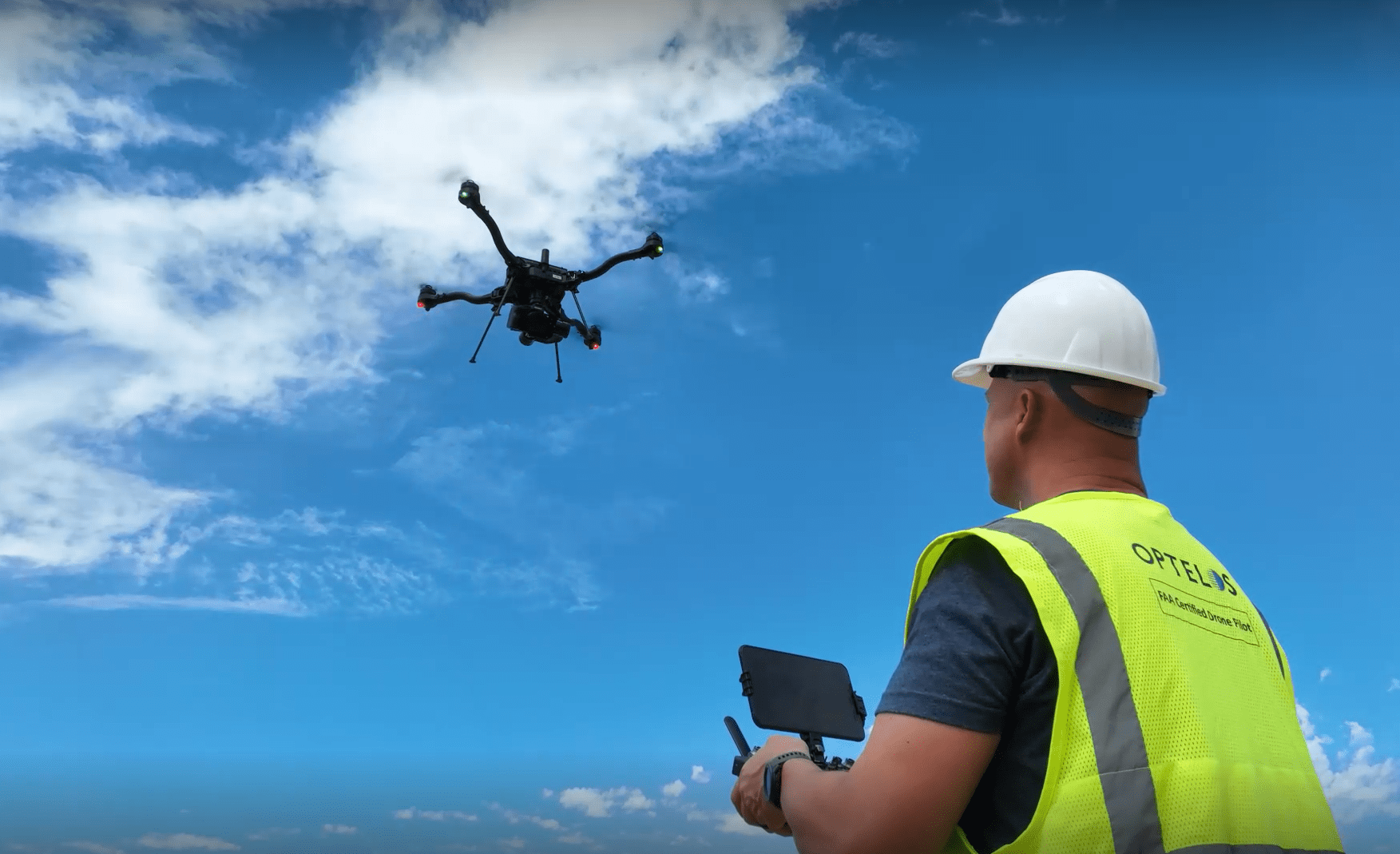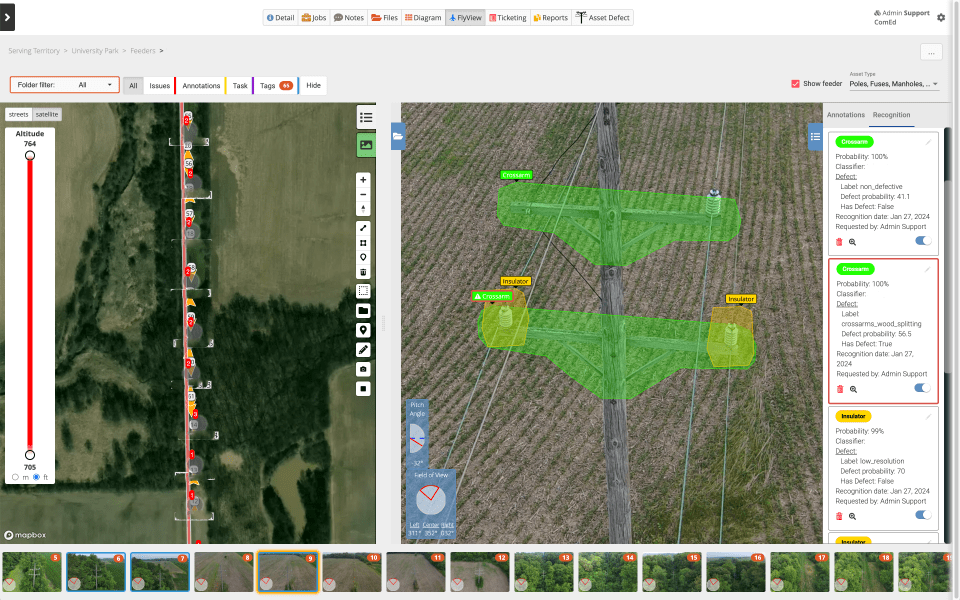Hyatt Regency McCormick Place, Chicago, IL
Utility Analytics Week 2024, held from October 15-17 at McCormick Place in Chicago, Illinois, was a significant event that brought together key stakeholders from the utility sector to explore the latest advancements in utility operations, data analytics, and technology, including drone inspection and AI technology in utilities. With a strong focus on harnessing data-driven insights and innovative solutions, this year’s conference spotlighted critical industry challenges, including asset management, maintenance, and inspection. As utility companies face increasing pressures from aging infrastructure, extreme weather events, and rising operational costs, emerging technologies such as drones and artificial intelligence (AI) are playing a transformative role in addressing these issues.
One of the primary themes of the event was the integration of drone inspection technology and AI-powered computer vision into asset management processes. These innovations have opened up new possibilities for improving operational efficiency, enhancing safety, and reducing maintenance costs. The adoption of drones, in particular, has proven to be a game-changer in asset monitoring, enabling utilities to conduct routine inspections faster, safer, and more cost-effectively. Coupled with AI, drones offer powerful tools for real-time data analysis and decision-making, significantly improving the accuracy of inspections and maintenance strategies.
The Growing Need for Advanced Asset Inspections
In the utility sector, asset inspections are crucial to ensuring that critical infrastructure—such as transmission & distribution lines, substations, transformers and vaults—remain in optimal working condition. However, traditional inspection methods, which often rely on manual surveys conducted by inspectors, are not only time-consuming and costly but also pose safety risks to personnel. Moreover, human errors in these manual inspections can lead to missed issues or incorrect data, resulting in unexpected outages or even catastrophic failures.
Given the challenges posed by aging infrastructure, extreme weather conditions, and the complexity of modern utility networks, there is an increasing need for more efficient, scalable, and reliable methods of asset inspection. The demand for more advanced inspection technologies has led to the growing adoption of drones and AI-driven solutions in the industry.
“The good thing here is it doesn’t take long to start, because labelling images is not that difficult. Financially, it’s not that challenging, and time-wise it doesn’t take that long.”
Boris Aronchik
AI Specialist Leader, Deloitte

Boris Aronchik, AI Specialist Leader, Deloitte, explains the technical AI details of the ComEd Case Study at UA Week 2024
Adoption of Drones for Asset Inspections
Drones have become an increasingly popular tool for asset inspection in the utility sector. A session at the conference titled “Harnessing Drone Technology for Asset Inspections” explored the widespread use of Unmanned Aerial Vehicles (UAVs) for inspecting hard-to-reach or hazardous areas such as power lines, substations, and other infrastructure. The utility sector has recognized the value of drones in performing routine inspections more efficiently, with the added benefit of minimizing human risk and reducing operational costs.
Drones equipped with high-resolution cameras, thermal sensors, LiDAR, and other cutting-edge technologies allow utility operators to gather real-time, high-quality data from asset inspections. This data can be analyzed in the field or sent to centralized systems for deeper analysis. The advantage of drones lies in their ability to quickly and safely capture a wealth of data, enabling utilities to identify potential maintenance needs before they result in major failures or outages.
One of the key advantages of drone inspections is the ability to reduce human risk and perform inspections more quickly and completely. Traditionally, utility workers would need to drive along lines taking pictures with PTZ camera or access hazardous or difficult to reach areas to inspect assets, putting themselves at risk of injury. With drones, however, inspections can be carried out remotely, keeping workers out of harm’s way while providing very high-quality imagery, often taken at a more effective angle and distance.
Furthermore, drones are far more efficient than manual inspections. Traditional asset inspections may take hours or days to complete, especially when inspecting large infrastructure. Drones, on the other hand, can cover vast areas in a fraction of the time, making it easier for utilities to keep track of asset conditions and identify issues like corrosion, cracks, broken cross arms, rotting pole tops or wear and tear in real-time.

Drone technology continues to improve with new platforms that offer higher resolution cameras, longer battery life for extended missions and enhanced drone control capabilities.
AI and Computer Vision: Enhancing the Inspection Process
Once the drone collects the inspection data, the power of AI and computer vision takes over. As discussed in the session “ComEd Case Study: Automating Grid Analytics with Drone Inspection and Computer Vision AI”, Deloitte and Optelos showcased how the Optelos platform leverages drone technology to automate the collection of visual data from distribution assets, such as poles, insulators, transformers and other infrastructure. Drones are equipped with high-resolution cameras to capture detailed imagery of grid components. The data collected by the drones is then processed and analyzed using ComEd’s proprietary computer vision AI algorithms, which can automatically detect anomalies and defects in the infrastructure. This enables ComEd to move from traditional reactive maintenance models to a more proactive, human + machine data-driven approach.
The AI system has been trained on vast datasets of previously inspected assets, which allows it to learn to spot common issues that might be difficult for a human to detect in large volumes of data. By automating this part of the process, ComEd can receive instant feedback about the condition of their assets, enabling them to make faster, more informed decisions about necessary repairs or replacements.
Benefits for Utilities: Efficiency, Cost Savings, and Safety
Throughout the session, Optelos emphasized the tangible benefits that drone inspections and AI-driven analytics provide to utilities. These include:
- Increased Efficiency: Drone inspections can be completed in a fraction of the time it would take for manual inspections. This allows utilities to inspect more assets more frequently, which leads to more accurate, up-to-date information about the condition of their grid.
- Cost Savings: By automating the inspection process and reducing the need for human inspectors to physically climb poles or access dangerous locations, utilities can lower the overall cost of asset inspections. Additionally, by catching issues early, utilities can avoid expensive emergency repairs or downtime.
- Improved Safety: Drones allow utilities to inspect hazardous or hard-to-reach locations without putting human inspectors at risk. This is particularly important for high-voltage transmission lines or areas prone to extreme weather conditions.
- Predictive Maintenance: By integrating AI-based analysis with historical data, utilities can move beyond simple visual inspections and adopt a predictive maintenance model. With real-time data and advanced analytics, utilities can predict when assets are likely to fail and perform maintenance before critical failures occur, leading to better grid reliability and fewer service interruptions.

ComEd is utilizing computer vision AI to automatically analyze drone-captured imagery to gain deeper, near real-time insights into the condition of their distribution assets.
Impact on Maintenance and Decision-Making
The use of drones and AI technology extends far beyond just inspections. It has also led to a shift from reactive maintenance to a more predictive and proactive approach. Traditionally, utilities have relied on reactive maintenance, where assets are inspected to discover issues, but the manual inspection method limits capacity and issues are often only discovered once problems arise, often resulting in unplanned downtime and higher repair costs. However, with drones and AI, utilities can continuously monitor the health of their assets, allowing them to detect issues before they cause failures.
One case study shared at the conference by Duke Energy highlighted the use of drones and AI to predict potential failures in their transmission network. By continuously collecting real-time data on asset conditions, Duke Energy was able to make data-driven decisions about when to replace or repair equipment, resulting in better resource allocation and reduced operational costs. This predictive maintenance model has led to fewer service interruptions and better grid reliability, showcasing how AI and drone technology can streamline decision-making and improve maintenance strategies.
Regulatory and Operational Challenges
While the benefits of drones and AI in asset inspections are clear, the industry still faces several regulatory and operational challenges. One of the key issues discussed during the conference was the complex regulatory landscape surrounding drone operations. In the U.S., the Federal Aviation Administration (FAA) has strict regulations governing the use of drones, particularly for commercial purposes. Utility companies must ensure that they comply with these regulations, which can vary by state and region.
Additionally, operational challenges related to data management and integration were a focal point at the conference. As utilities adopt drones and AI for inspections, they are collecting large volumes of data that must be stored, processed, and integrated with existing asset management systems. Many utilities are still working to streamline these processes to ensure that the data they collect is actionable and can be effectively used to drive decision-making. Consolidating visual data management platforms like Optelos can make this transition much easier by enabling streamlined workflows and system integrations for simplified data leverage and AI management.
Future Outlook and Emerging Trends
Looking forward, several emerging trends were discussed at the event, signaling the continued evolution of drone and AI technology in utility asset inspections. These include:
- Autonomous Drone Inspections: The next frontier for drone technology is full autonomy. While current drones require human operators, there is growing interest in developing fully autonomous drones that can perform inspections with minimal human intervention. This would further enhance the efficiency and scalability of drone operations.
- 5G and Edge Computing: The rollout of 5G networks and advances in edge computing are expected to play a significant role in enhancing drone operations. With 5G, drones will be able to transmit large datasets in real-time, while edge computing will allow data to be processed locally, reducing latency and improving the speed of analysis.
- Computer Vision AI Asset Inspection: Another trend is the integration of computer vision AI analysis of drone collected inspection data. AI can process thousands of images with consistently high accuracy, providing real-time insights and helping maintenance teams more quickly identify degraded assets and prioritize maintenance actions. In the future we can expect to see greater adoption of this technology for not only inspecting distribution and transmission assets, but also address asset location errors, third party attachment audits, vegetation management inspection automation and also storm preparations and response actions.
Conclusion
Utility Analytics Week 2024 provided a comprehensive look at the transformative impact of drone inspections and AI-powered analytics on asset management in the utility industry. As utilities continue to embrace these technologies, they are improving the accuracy, speed, and safety of their asset inspections while also reducing operational costs and minimizing downtime. With the shift from reactive to proactive maintenance models, drones and AI are playing a central role in shaping the future of utility operations.
By adopting these cutting-edge technologies, utilities are better equipped to manage aging infrastructure, respond to extreme weather events, and optimize resource allocation. As the industry moves toward more data-driven and automated approaches to maintenance and decision-making, drones and AI will continue to be at the forefront of these innovations, driving efficiency, reliability, and safety in utility asset management. The future of utility operations is becoming increasingly intelligent, connected, and resilient, with these technologies paving the way for smarter and more resilient grids.

